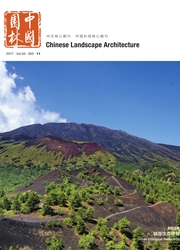

 中文摘要:
中文摘要:
以风景园林主观感受评价的数字量化为核心,阐述了作者提出的风景园林主观感受经由风景园林客观环境信息转译得到的原理:风景园林感受可以理解为风景园林客观环境信息被接收、转译、进而成为主观感受信息,这样一个信息编码、处理和传输的过程。阐述内容包括:风景旷奥度基本概念,风景感受的三层次空间模式,借以反映16个旷奥标准的指标测度。其中,以地形复杂度M0、景场地形起伏度M1、景场空间表面起伏度M2、景域视觉起伏度M3/景象丰富度M3'为例,给出了基于风景数字地表模型DTM数据的指标测度的数学演算公式。这一最初于30年前提出创立的原理对于今天尝试景观感受量化与量化评价研究实践具有重要的意义和作用。
 英文摘要:
英文摘要:
Focusing on the digitizing and quantification of landscape subjective evaluation, the principle of the subjective perception of landscape architecture through the objective environment information translation proposed by the authors was elaborated: landscape perception is a process from information coding, processing and transmission in which landscape objective environment information is received, translated, and thus becomes a subjective perception information. The contents this article described include: basic concept of landscape openness and serene ranking, two criteria for landscape spatial perception evaluation, and three-level spatial patterns of landscape perception based on landscape openness and serene, which are indicated by 16 openness and serene index and measurements. Taking the index of M0(complexity of terrain), M1(fluctuation of field terrain), M2(fluctuation of field terrain surface relief), M3(visual fluctuation of viewshed), and M3'(scene richness of viewshed) as the example, the calculus of the mathematical formula of the index and measure based on landscape digital terrain model(DTM) were demonstrated. One of the meaning and function of this principle, method and technique, initially proposed and created 30 years ago, is to provide a useful way for digitizing and evaluating the subjective-related perception of landscape through the translation of landscape objective environment information.
 同期刊论文项目
同期刊论文项目
 同项目期刊论文
同项目期刊论文
 期刊信息
期刊信息
